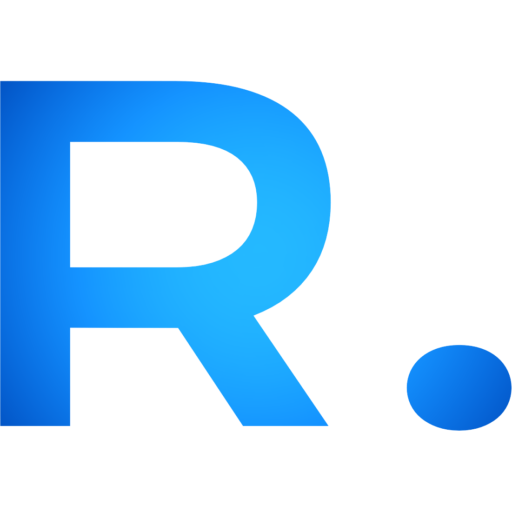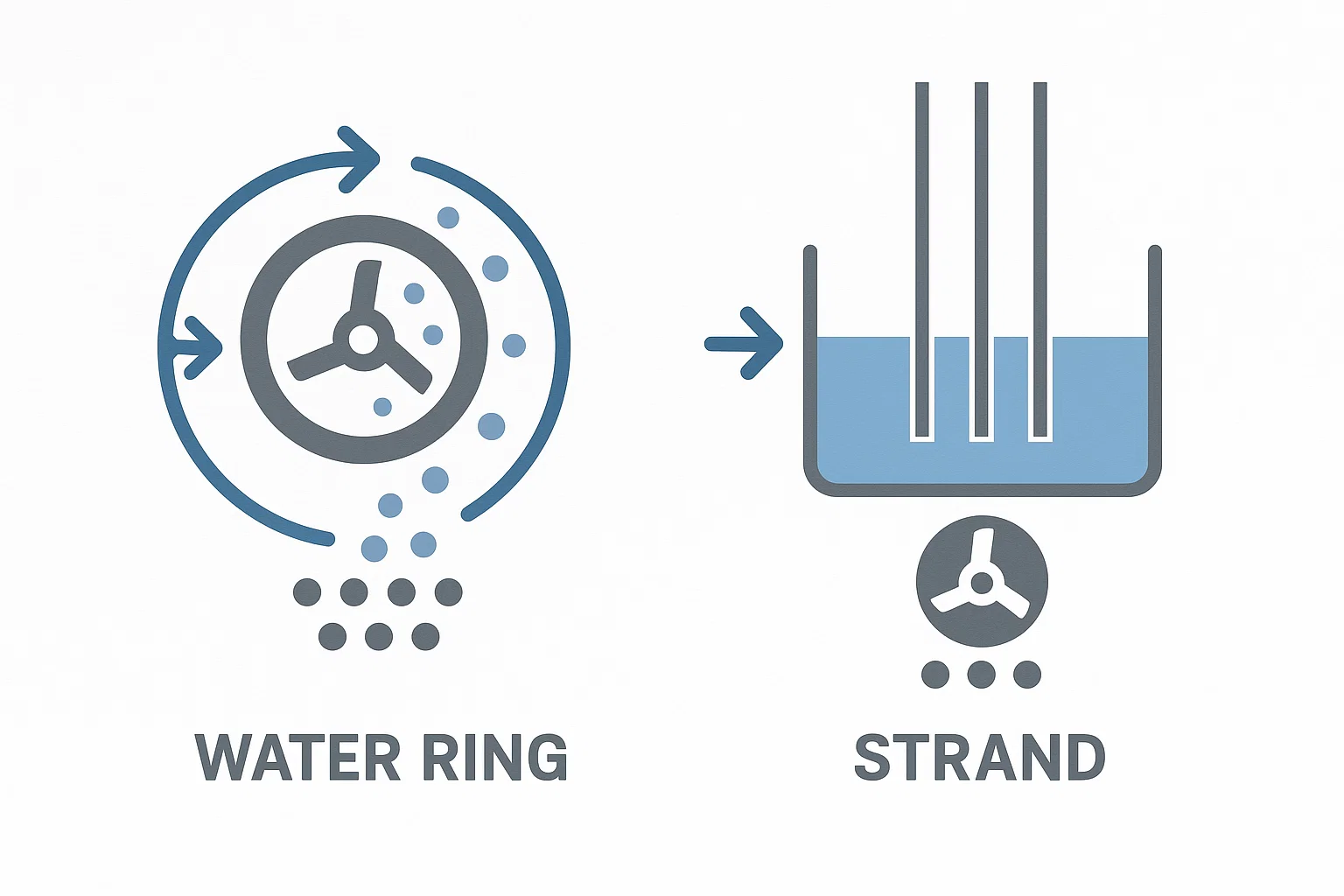소개
PET 생산 라인에 적합한 펠릿화 시스템을 선택하는 것은 운영 효율성, 제품 품질 및 장기적인 비용에 큰 영향을 미칠 수 있는 중요한 결정입니다. 가장 널리 사용되는 방법은 다음과 같습니다. 워터링 펠릿화 그리고 수냉식 스트랜드 펠릿화각 시스템은 고유한 장점을 가지고 있으며, 다양한 생산 목표와 시설 제약에 적합합니다.
~에 에너지클 머신저희는 미국과 유럽 전역의 제조업체들이 재활용 및 폴리머 가공 라인을 최적화할 수 있도록 지원하는 데 특화되어 있습니다. PET 플레이크용으로 설계된 시스템을 찾고 계시다면 저희를 방문하세요. PET 플라스틱 플레이크 단일 스크류 펠렛타이저 고효율 단일 스크류 솔루션에 대해 자세히 알아보려면 페이지를 참조하세요.
이 심층 가이드는 두 가지 펠릿화 기술을 균형 있게 비교하여 특정 요구 사항에 가장 적합한 기술을 결정하는 데 도움을 드립니다.
PET 펠릿화의 기본 이해
PET(폴리에틸렌 테레프탈레이트) 펠릿화는 플라스틱 재활용 또는 버진 폴리머 생산 라인의 후속 공정으로, 용융 PET를 고체 펠릿으로 변환하는 과정입니다. 이러한 펠릿은 제조 공정에서 취급, 운송 및 재사용이 용이합니다.
두 가지 주요 시스템은 다음과 같습니다.
- 워터링 펠릿화: 용융된 PET를 다이를 통해 압출한 후, 회전하는 블레이드를 사용하여 즉시 펠릿 형태로 절단합니다. 펠릿은 순환식 워터링에서 냉각됩니다.
- 수냉식 스트랜드 펠렛화: 용융 PET를 연속된 가닥으로 압출하고, 수조에서 냉각한 후 펠릿으로 절단합니다.
PET 병 플레이크의 경우, 에너지클 머신 또한 제공합니다 특수 펠릿화 시스템 안정적인 출력과 일관된 펠릿 품질을 위해 설계되었습니다.
설치 공간 및 공간 요구 사항
워터링 펠릿화
워터링 시스템은 소형이고 고도로 통합되어 있습니다. 바닥 공간을 적게 차지하므로 공간이 부족한 시설에 이상적입니다. 커터, 워터링, 건조기를 포함한 모든 주요 구성 요소는 일반적으로 하나의 장치로 조립됩니다.
수냉식 스트랜드 펠렛화
스트랜드 시스템은 냉각수통과 스트랜드 배치로 인해 더 넓은 바닥 공간이 필요합니다. 이러한 구성은 소규모 공장이나 기존 설비의 경우 제약이 될 수 있습니다. 그러나 다양한 재료 점도를 처리하는 데 있어 더 큰 유연성을 제공할 수 있습니다.
에너지클 머신 운영 공간에 가장 적합한 시스템이 무엇인지 파악하기 위해 공장 레이아웃을 평가하는 것이 좋습니다.
자동화 및 사용자 친화성
워터링 펠릿화
워터링 시스템은 일반적으로 자동화 수준이 높고 작업자 개입이 적습니다. 블레이드 압력은 종종 자동 조절되며, 펠릿 건조 기능이 통합되어 있어 수동 조작의 필요성이 줄어듭니다.
수냉식 스트랜드 펠렛화
스트랜드 펠릿화 시스템은 노동 집약적입니다. 작업자는 스트랜드 정렬과 물 흐름의 일관성을 유지해야 합니다. 시동 및 정지 시 더 많은 주의와 기술이 필요합니다.
노동비 절감과 일관성 향상을 목표로 하는 제조업체의 경우, 에너지클 머신 자동화의 이점을 위해 워터링 펠릿화를 고려하는 것이 좋습니다.
펠릿 모양 및 품질
워터링 펠릿화
광택 마감 처리된 둥글고 균일한 펠릿을 생산합니다. 특히 펠릿의 미관과 유동성이 중요한 고급 용도에 적합합니다.
수냉식 스트랜드 펠렛화
펠릿은 일반적으로 원통형이며 끝이 약간 불규칙합니다. 대부분의 후속 용도에는 여전히 적합하지만, 고급 미관이나 가공 기준을 충족하지 못할 수 있습니다.
펠릿의 균일성과 외관이 귀하의 적용에 중요한 경우, 에너지클 머신 워터링 시스템을 권장합니다.
요약 비교표
| 특징 | 워터링 펠릿화 | 수냉식 스트랜드 펠렛화 |
|---|---|---|
| 발자국 | 콤팩트 | 더 넓은 공간이 필요합니다 |
| 오토메이션 | 높은 | 중간에서 낮음 |
| 펠릿 모양 | 둥글고 균일하다 | 원통형, 가변형 |
| 유지 | 보통의 | 마모 위험 감소 |
| 초기 비용 | 더 높은 | 낮추다 |
| 운영 비용 | 장기적으로 낮음 | 더 높은 노동 비용 |
| 처리량 | 높은 | 중간 |
| 재료 유연성 | 중간 | 높은 |
자주 묻는 질문
질문 1: 기존 PET 라인에 워터링 펠렛타이저를 추가로 장착할 수 있나요?
네, 많은 에너지클 머신모델은 개조를 위해 설계되었지만, 레이아웃과 압출 매개변수를 평가해야 합니다.
Q2: 재활용 PET에 더 적합한 펠렛화기는 무엇입니까?
워터링 펠릿화는 처리량이 더 높고 건조 기능이 우수하기 때문에 재활용 PET에 더 적합한 경우가 많습니다.
Q3: 하이브리드 시스템이 있나요?
일부 시스템은 두 가지 펠릿화 유형의 특징을 결합한 모듈식 옵션을 제공합니다. 에너지클 머신 맞춤형 솔루션에 대해 상담할 수 있습니다.
Q4: 워터링 시스템으로 업그레이드할 경우 일반적으로 투자 회수 기간은 얼마나 됩니까?
생산량과 인건비에 따라 투자 회수 기간은 1년에서 3년까지 다양합니다.
생산 라인에 맞는 올바른 선택을 하세요
올바른 펠릿화 시스템을 선택하면 PET 생산 라인의 미래를 형성할 수 있습니다. 에너지클 머신 정보에 입각한 미래 지향적인 투자를 할 수 있도록 도와드립니다.
저희를 방문하세요 PET 플라스틱 플레이크 단일 스크류 펠렛타이저 페이지를 방문하거나 오늘 저희에게 연락하여 귀하의 요구 사항을 논의해 보세요.
맞춤형 견적 요청


